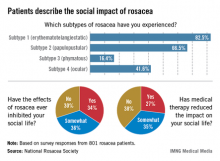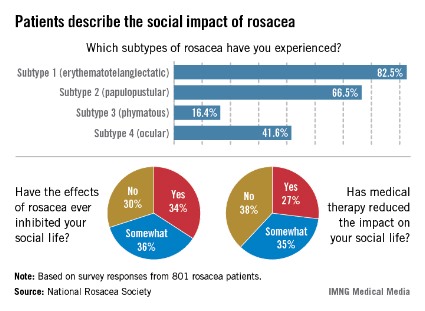User login
The phymatous form of rosacea (subtype 3) has the most profound negative effect on patients’ social lives, compared with other subtypes, according to a survey by the National Rosacea Society.
More than 82% of those surveyed said that they had experienced erythematotelangiectatic rosacea (subtype 1), compared with 66.5% reporting symptoms of papulopustular (subtype 2), 16.4% reporting phymatous (subtype 3), and 41.6% reporting ocular (subtype 4) rosacea, the society said.
When analyzed by subtype, those patients with subtype 3 were most likely (85%) to have their social lives negatively affected. Those with subtype 2 were the next most likely to be negatively affected (77%), followed by subtype 4 (71%) and subtype 1 (61%), according to the survey data.
However, approximately two-thirds (62%) of the respondents said that medical therapy had at least somewhat reduced the negative impact of rosacea on their social lives.
The phymatous form of rosacea (subtype 3) has the most profound negative effect on patients’ social lives, compared with other subtypes, according to a survey by the National Rosacea Society.
More than 82% of those surveyed said that they had experienced erythematotelangiectatic rosacea (subtype 1), compared with 66.5% reporting symptoms of papulopustular (subtype 2), 16.4% reporting phymatous (subtype 3), and 41.6% reporting ocular (subtype 4) rosacea, the society said.
When analyzed by subtype, those patients with subtype 3 were most likely (85%) to have their social lives negatively affected. Those with subtype 2 were the next most likely to be negatively affected (77%), followed by subtype 4 (71%) and subtype 1 (61%), according to the survey data.
However, approximately two-thirds (62%) of the respondents said that medical therapy had at least somewhat reduced the negative impact of rosacea on their social lives.
The phymatous form of rosacea (subtype 3) has the most profound negative effect on patients’ social lives, compared with other subtypes, according to a survey by the National Rosacea Society.
More than 82% of those surveyed said that they had experienced erythematotelangiectatic rosacea (subtype 1), compared with 66.5% reporting symptoms of papulopustular (subtype 2), 16.4% reporting phymatous (subtype 3), and 41.6% reporting ocular (subtype 4) rosacea, the society said.
When analyzed by subtype, those patients with subtype 3 were most likely (85%) to have their social lives negatively affected. Those with subtype 2 were the next most likely to be negatively affected (77%), followed by subtype 4 (71%) and subtype 1 (61%), according to the survey data.
However, approximately two-thirds (62%) of the respondents said that medical therapy had at least somewhat reduced the negative impact of rosacea on their social lives.

